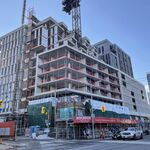It'll be quick but not that quick. If it took only 50 mins then it would be as fast as the Bloor-Danforth subway. Obviously, that's not going to be the case. It'll take well over an hour. Hopefully, the time saved from having to transfer at Kipling and ride the bus to the airport will compensate for the longer ride.
Why will it take over an hour if the line is 31km?
The MAX reference I used goes through several blocks of traffic signals, I think its close to 10km, right through downtown Portland. And it manages to travel the distance in 50 minutes.
Edit: I just mapped out Portland's MAX as it goes through downtown and the central city. It spends 7.5km through intense urban street crossings (not long-spaced suburban crossings that are more quick) so compare that to the fewer than 20 intersections that Eglinton Crosstown will go through, I think its entirely accurate to expect Eglinton Crosstown to go through its entire 31 km route in 50-55 minutes. The 7.5km MAX downtown-east side route does not include other sections in other parts of the metro area it crosses traffic, and there are several other MAX sections that cross traffic. I used to live in Beaverton, and some of the stops were so close you could see the other station from Beaverton TC... I just fail to see how the Eglinton Crosstown LRT will be as slow as some people suggest.
Here's a calculation I've come up with.
Portland MAX Blue Line is 53km long. Source:
http://en.wikipedia.org/wiki/MAX_Blue_Line
According to the schedule, it takes 1 hour and 38 minutes to do a complete trip Source:
http://trimet.org/schedules/maxblueline.htm
53km divided by 98 minutes = .54km a minute
MAX Blue Line goes through central Gresham, central Hillsboro, and downtown Portland. A significant portion is through urban downtowns, Hillsboro and Gresham each have about 100,000 residents and are urban for American suburban standards.
.54km/minute is a viable speed for Eglinton Crosstown. .54km x 60 minutes = 32.4km
So I believe you're right, it will take right at 1 hour from trains leaving Pearson airport to arrive at Kennedy.
Eglinton Crosstown is reported to be only 30.8km according to this source:
http://en.wikipedia.org/wiki/Eglinton_Crosstown_LRT_(TTC)
If this is true, I don't see how it can't achieve crosstown travel in 55 minutes, just under one hour. If MAX Blue Line goes across intersections throughout 4 downtowns: Portland, Gresham, Hillsboro, Beaverton (population 550,000, 120,000, 100,000, 100,000 respectively) and achieves this at .54km/minute, I fail to see how Eglinton will be ANY slower when it only goes through fewer than 20 suburban intersections.
This is the most scientific hypothesis I've seen yet as to what to expect, and given my personal experience of living in Portland nearly 1 year and using the Blue line to get to work, I think that is what you can expect with Eglinton Crosstown.
This LRT speed issue isn't as bad as it was once thought. The MAX crosses many suburban thoroughfares and downtown streets, and Eglinton Crosstown has the benefit of the entire central 10km core being tunneled with 850m spaced stops.
My hope is that they build the platforms capable of handling a minimum of 3 cars per train, because Portland MAX is only capable of 2 cars per train (2 compartments per car). If 3 cars per train are ran all day/all night on Eglinton Crosstown, this LRT could easily handle over 400-500k passengers a day no problem at all.




